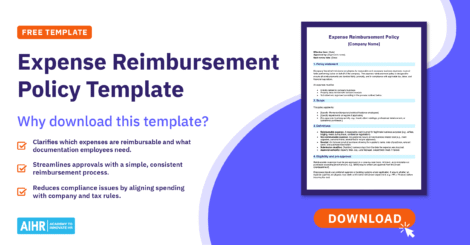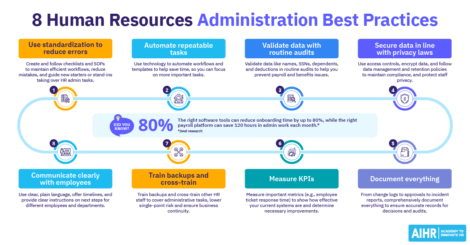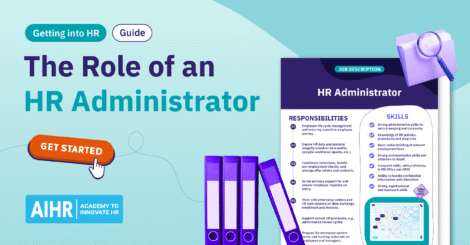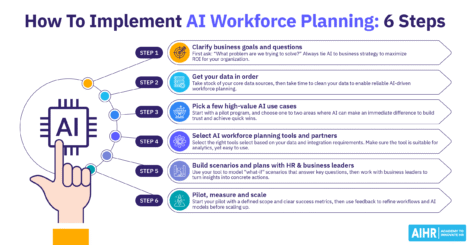A roles and responsibilities template forms the foundation for writing meaningful job descriptions, defining team duties, and communicating expectations effectively. This is crucial because assigning tasks without clearly outlining the scope and purpose of a role rarely drives high performance.
When employees understand why their job exists and what’s expected of them, they gain the clarity, direction, and accountability needed to stay engaged and motivated. According to Vroom’s expectancy theory of motivation, people are more likely to perform well when they believe their efforts will lead to desirable outcomes.
By using a structured approach to defining job roles and responsibilities, HR teams can strengthen recruitment, onboarding, and performance management and, in turn, boost overall organizational success. This article explains what a job roles and responsibilities template is, shares examples of well-defined roles, and includes four free downloadable templates.
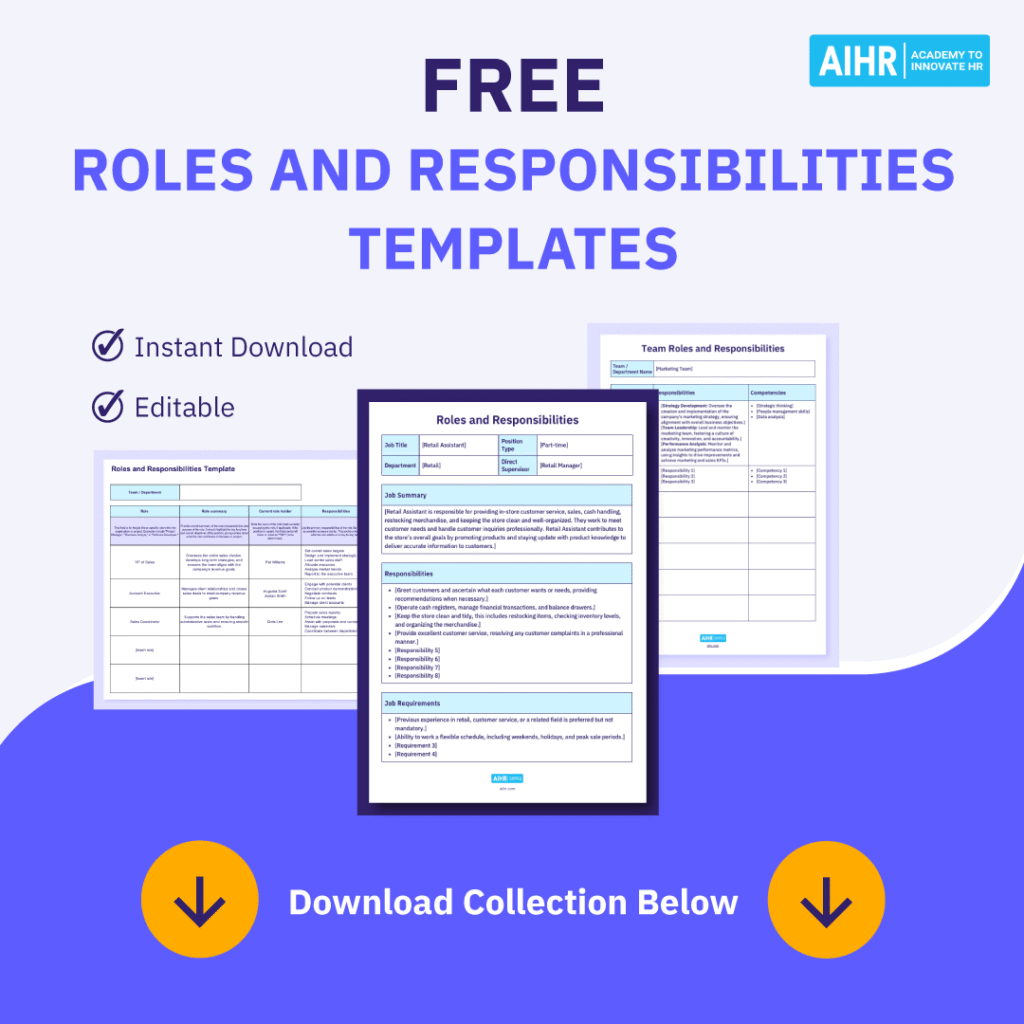
Contents
What are roles and responsibilities?
Important terms to know
Benefits of defining roles and responsibilities
How to define roles and responsibilities
Key elements of a role and responsibilities template
When to use the roles and responsibilities template
Free roles and responsibilities templates
How to fill in a roles and responsibilities template
Roles and responsibilities template vs RACI template
Examples of roles and responsibilities
Company examples of roles and responsibilities
FAQ
What are roles and responsibilities?
Roles and responsibilities define the specific tasks, duties, and expectations associated with each position within an organization. Clearly outlining these responsibilities helps streamline workflows, prevent confusion, and ensure that every critical function is carried out efficiently. It also gives employees a solid understanding of what’s expected of them, supporting accountability, empowerment, and effective performance tracking.
For HR professionals, having a deep understanding of both HR roles and responsibilities and those across the wider organization is essential. This knowledge allows you to hire candidates with the right skills and experience for each position. When a role evolves or new responsibilities are added, it’s important to communicate those changes clearly and provide the necessary training so employees can adapt successfully.
Managing roles and responsibilities also has a cultural dimension. When HR understands how each position fits into the broader structure, it becomes easier to spot and resolve overlaps or gaps that might cause tension between team members. This clarity helps build a more collaborative and respectful workplace where everyone knows their part in achieving shared goals.
Important terms to know
Let’s take a closer look at some key terms related to roles and responsibilities.

Benefits of defining roles and responsibilities
Clearly defining roles and responsibilities benefits both employees and the organization. It creates structure, supports engagement, and helps teams work more efficiently. Here are some of the key advantages:
- Clear expectations: When employees know exactly what’s expected of them, they can focus their energy where it matters most. This clarity helps them prioritize tasks, avoid hesitation, and gain greater satisfaction from their work. It also allows them to see how their contributions tie into the organization’s overall success, which strengthens motivation and engagement.
- Enhanced performance: Research shows that job clarity has a direct impact on how effectively employees carry out their responsibilities. When people understand their role and its purpose, they’re more confident, proactive, and efficient with their time. This not only improves individual performance but also drives team productivity.
- Improved accountability: When responsibilities are clearly defined, it’s easier to track performance and evaluate results fairly. Employees understand what they’re accountable for, which promotes ownership and reduces confusion about who’s responsible for what. This transparency helps teams operate more smoothly and minimizes conflict.
- Stronger collaboration and teamwork: Clarity around roles benefits individuals and improves teamwork. When employees understand their own and others’ responsibilities, they communicate more effectively and coordinate tasks with fewer overlaps. This builds trust and encourages collaboration, reducing friction caused by misunderstandings over task ownership or workload distribution.
- Greater organizational agility: Unclear roles can slow an organization down when facing change or new opportunities. If employees don’t know who should take action, progress stalls. With well-defined roles, everyone understands their responsibilities and can adjust their priorities when internal or external circumstances shift, making the organization more adaptable and responsive.
- Smoother onboarding: New hires perform better when they start with a clear understanding of their role. Providing a detailed overview of their responsibilities helps them focus on what’s most important, reducing overwhelm and shortening the adjustment period. This sets them up for success from day one.
HR tip
Nearly 30% of employees leave a job within the first 90 days, and studies show that 41% of them do so because the role didn’t match their expectations. To reduce early turnover, make sure your job descriptions clearly explain the day-to-day responsibilities, expected outcomes, and the type of person who will thrive in the role.
How to define roles and responsibilities
It’s important to lay the groundwork before completing a roles and responsibilities template. Using a straightforward, structured method ensures consistency and accuracy across the organization. Here is a step-by-step process to follow:
- Describe the role’s purpose: Begin with a concise statement that explains why the role exists. Summarize its main objectives and how they contribute to both the team’s success and the organization’s overall mission.
- List core tasks: Outline the key responsibilities and everyday activities tied to the position. Keep the descriptions clear and straightforward; specific enough to provide guidance, but flexible enough to allow for growth and creativity. Avoid vague phrasing or unnecessary detail that could cause confusion.
- Consult stakeholders: Gather input from managers, team members, and cross-functional partners. Their perspectives help you capture all relevant expectations and prevent gaps or overlaps in duties. Reviewing workflows and task ownership at this stage ensures that responsibilities are distributed effectively.
- Determine the reporting structure: Clarify reporting relationships and decision-making authority. Employees should understand who they report to, who (if anyone) reports to them, and how approvals and escalations work. This reinforces accountability and helps maintain a smooth chain of command.
Key elements of a role and responsibilities template
A roles and responsibilities template provides a structured format for defining and communicating what’s expected from each position within an organization. It gives both the employee and employer a shared understanding of the role’s objectives, performance standards, and contribution to broader goals.
A well-designed template typically includes:
- Role title: A clear, descriptive job title that immediately communicates the position’s primary purpose.
- Department or team: Identifies where the position sits within the organization, establishing its context and reporting line.
- Reporting structure: Outlines who oversees the role, whether it includes direct reports, and which departments or colleagues it works closely with.
- Role summary: A brief overview of the role’s purpose and objectives, clarifying its scope and key outcomes.
- Key responsibilities: A list of the main duties and tasks that define what success looks like in the role.
- Skills and qualifications: Specifies the technical abilities, soft skills, education, and training required to perform effectively.
When to use the roles and responsibilities template
There are several scenarios where HR professionals use a template for roles and responsibilities:
- For a new position: When creating a new role, a template helps define why the position exists and what’s expected from the person filling it. This clarity attracts the right candidates and gives recruiters and hiring managers clear criteria for evaluating applicants.
- During organizational restructuring: In times of change, such as mergers, realignments, or departmental shifts, roles often evolve. Using a roles and responsibilities template helps HR redefine expectations and communicate them clearly, especially for employees adapting to new structures or reporting lines.
- For employee onboarding: A well-defined template helps new hires understand their role from the first day. It sets expectations, clarifies priorities, and aligns them with company culture and processes. It also serves as a foundation for a structured 30-60-90 day plan, giving new employees a clear roadmap for success.
- In performance management: Having a documented list of roles and responsibilities allows managers to objectively assess performance during reviews. It helps determine whether employees are meeting expectations and provides a fair basis for feedback, goal-setting, and development discussions.
- In succession planning: When preparing employees for future leadership roles, templates offer benchmarks for what each position requires. This helps identify skill gaps, guide development efforts, and ensure smoother transitions into critical or senior roles.
- For performance improvement: In cases where performance issues arise, the roles and responsibilities template can serve as a reference point. Comparing an employee’s performance against documented expectations highlights specific gaps. Combined with a performance improvement plan (PIP), it helps create a targeted, step-by-step strategy for improvement.
Build a strong HR foundation that supports clarity and performance
Clear roles and responsibilities are at the core of effective onboarding, performance reviews, and workforce planning. Whether you’re creating job documentation or working across teams, having structured HR practices helps everyone stay aligned.
With AIHR’s HR Generalist Certificate Program, you will:
✅ Strengthen HR fundamentals across the employee lifecycle.
✅ Improve collaboration by clarifying roles, processes, and expectations.
✅ Support key HR activities like onboarding, reviews, and workforce planning.
✅ Gain practical tools to build consistency across HR operations.
🎓 Get equipped to lead confident, well-organized HR initiatives.
Free roles and responsibilities templates
Get access to a complete collection of roles and responsibilities templates, available in editable Word, Excel, and PowerPoint formats. Each format also includes a version tailored for teams, designed to help you define, communicate, and organize job expectations clearly and effectively.
1. Roles and responsibilities template in Word
The Word template provides a flexible and easy-to-use format for outlining duties, expectations, and reporting lines. It’s ideal for creating polished job descriptions or documenting role definitions that managers and employees can easily reference.

2. Roles and responsibilities template in Excel
The Excel template works best for capturing roles and responsibilities in more detail, whether for an individual position or across a team. Its structured layout makes customization and updates straightforward, ensuring information stays organized and accessible.

3. Roles and responsibilities template in PowerPoint
The PowerPoint version helps visualize roles and responsibilities in an engaging way. Customize the layout, graphics, and color scheme to present job structures, expectations, and reporting lines clearly in meetings or training sessions.
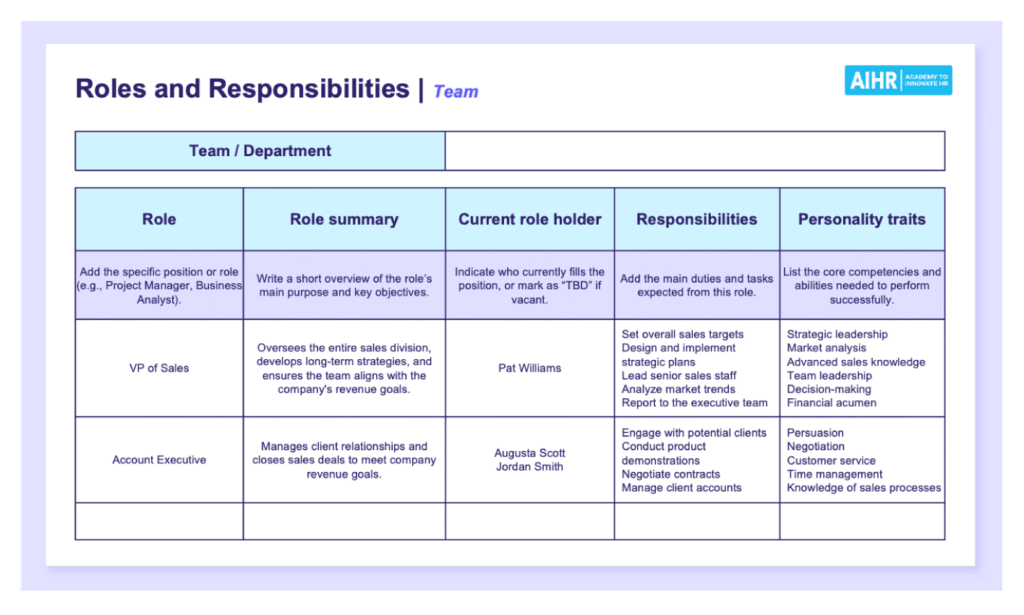
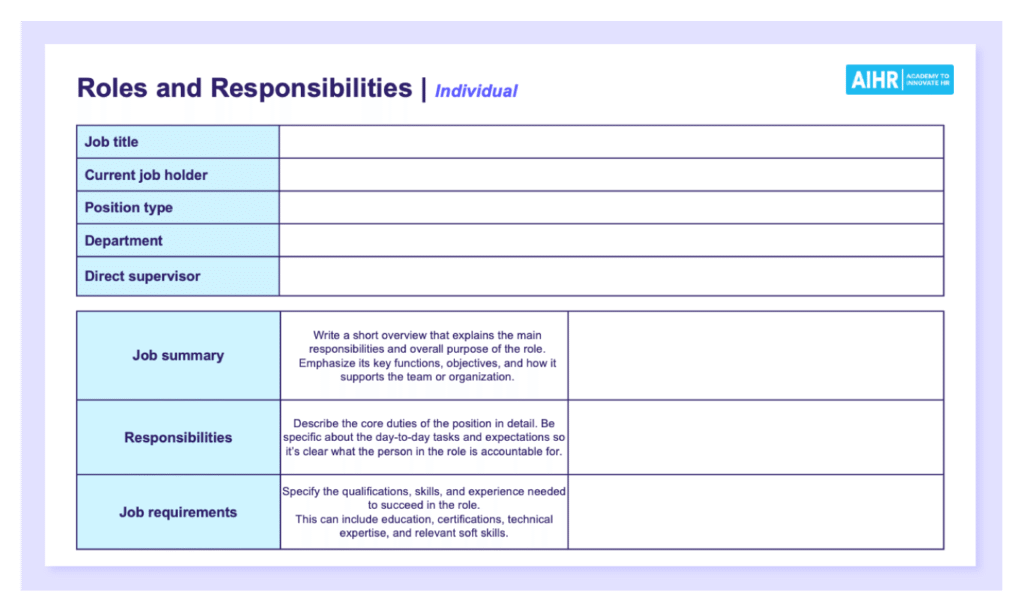
How to fill in a roles and responsibilities template
Filling out a roles and responsibilities template effectively is about capturing every important detail about the role and its duties, providing clarity to the (future) job holder, the team, and the broader organization. Here’s how to do it step by step:
- Step 1: Use a clear, specific job title that accurately reflects the position. Avoid overly creative titles that might confuse candidates or colleagues.
- Step 2: Gather information by speaking with managers, team leaders, and current role holders. Their insights help ensure the description is accurate and complete.
- Step 3: Write a concise summary explaining the role’s main purpose and its importance to the team or organization. This sets the context for the detailed information that follows.
- Step 4: List the key duties and daily tasks associated with the position. Include both short-term and long-term responsibilities, and format them as bullet points for easy reading.
- Step 5: Define the essential and preferred qualifications, such as technical skills, soft skills, education, and experience. Distinguish between must-have and nice-to-have competencies.
- Step 6: Review and update the template periodically to reflect changes in the role, team structure, or business priorities. Keeping documentation current maintains clarity and alignment across the organization.
The do’s and don’ts of filling in a roles and responsibilities template
Use clear, concise, gender-neutral language
Use vague or misleading terms
Break down responsibilities and requirements into bullet points for easy reading
Overload the template with unnecessary detail
Start with the most critical tasks and responsibilities so they’re seen and prioritized
Skip important duties or leave gaps that may cause confusion
Tailor the content to reflect the unique aspects of each role—some may require more detail than others
Assume readers know the implicit tasks linked to a role; always spell out key responsibilities clearly
Roles and responsibilities template vs. RACI template
A roles and responsibilities template and a RACI template (which stands for Responsible, Accountable, Consulted, and Informed) serve different but complementary purposes.
The RACI template is more of a task-level framework that is suitable for delineating project accountability. A roles and responsibilities template is an all-inclusive depiction of a specific function within the organization that works well for ongoing HR processes.
As an HR professional, it’s important to know when to use which template for the best results in your organization.
Purpose
- Outlines the duties, expectations, reporting lines, and qualifications tied to a particular role
- Aligns individual contributions with organizational goals and ensures clarity in ongoing functions
- Uses a matrix to define who is responsible, accountable, consulted, and informed for each project task or deliverable
- It prevents overlap, confusion, and missed handoffs
Application
Applies to overarching job roles and ongoing responsibilities
Applies to specific tasks or deliverables within a project
Focus
Role-focused
Task-focused
Use case
Best used when defining job roles during onboarding, restructuring, performance management, or succession planning
Typically used by project managers but also valuable in HR—for instance, when implementing a new HR system or managing cross-functional initiatives where clear accountability is essential
Examples of roles and responsibilities
Let’s take a look at three role description examples:
Example 1: HR Generalist
Example 2: HR Specialist
Example 3: Sales manager

Company examples of roles and responsibilities
Here are a few real-world examples from companies that clearly define roles, expectations, and values in their job descriptions.
Example 1. Zerotier: Staff Infrastructure Engineer

Why this is a strong example:
- Clarity and detail: This post clearly breaks down what the job entails, what kind of experience is expected from candidates, and the qualifications necessary to be successful in the role. This helps potential candidates assess whether they are a good fit for the position.
- Desired hard and soft skills: A job role that outlines both hard and soft skills, such as the need for communication, collaboration, and cross-functional leadership skills, will attract candidates who can fulfill the technical aspects of the job, plus effectively communicate and work in a team.
- Mission alignment: The brief introduction of the company, its mission, and background helps candidates understand the core values and objectives of the company, allowing them to assess if their personal values and career goals align with the company’s mission.
Example 2. Preply: Payments Manager

Why this is a good example of job responsibilities:
- Purpose and impact: The description presents the Payments Manager as a key role driving Preply’s growth through initiatives to reduce costs and increase monetization. This gives candidates a sense of how their work contributes to business success.
- Transparent expectations: The “What you’ll be doing” section lays out clear, specific responsibilities. Candidates know exactly what’s expected of them day to day and what success looks like in the long term.
- Focus on culture and values: By including the “Our Principles” section, Preply highlights its company culture and the qualities it values most. This helps attract candidates who share those values and will thrive in the organization.
Example 3. Slack: Staff Data Scientist
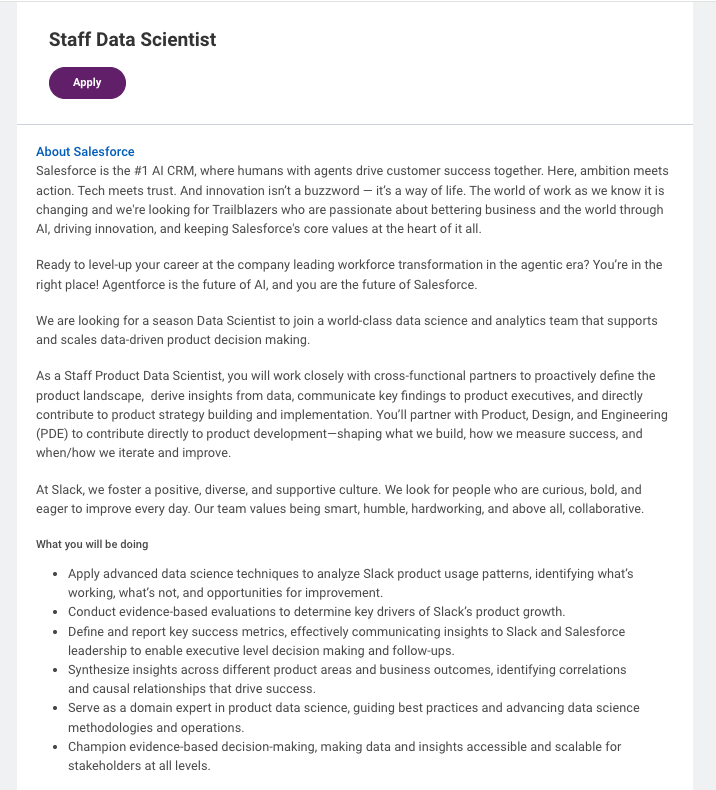
Why this is a good example of job roles and responsibilities:
- Comprehensive scope: The role description explains how the Staff Data Scientist contributes to both the analytical and strategic sides of product development. It shows candidates that the position involves technical execution as well as influencing broader decisions.
- Clear impact areas: Each responsibility links to measurable outcomes—from identifying growth drivers to defining success metrics—giving candidates a transparent picture of what high performance looks like.
- Balanced skill focus: The qualifications include advanced technical skills (Python, R, Spark, Airflow) alongside communication and collaboration. This balance makes it clear that success in the role requires both data expertise and teamwork.
Example 4. Capital One: Business Manager – EPX Strategy

Why this is an effective example:
- Concise overview: The summary provides a quick but thorough explanation of the role’s purpose, key responsibilities, and ideal candidate profile. This upfront clarity draws candidates in immediately.
- Functional clarity: By stating that the role works closely with multiple teams, the listing makes collaboration expectations clear. Responsibilities are introduced with keywords, then expanded with brief explanations.
- Structured qualifications: Dividing qualifications into “basic” and “preferred” categories makes the listing more inclusive while still highlighting what will set candidates apart.
Over to you
Defining roles and responsibilities clearly and transparently helps set expectations for both candidates and employees. It also provides managers with a foundation for evaluating performance and making informed decisions as business needs evolve. A well-structured roles and responsibilities template is the ideal framework for managing this process consistently across your organization.
FAQ
Job roles refer to the specific positions or titles that individuals hold within an organization. Each job role has a defined set of duties, qualifications, and objectives, and serves as a way to organize the workforce. For instance, typical job roles include manager, software engineer, or sales representative, each contributing differently to the organization’s goals.
Job responsibilities are the specific tasks and duties an individual is expected to perform as part of their job role. These responsibilities ensure that the employee effectively contributes to organizational goals and objectives. Depending on the job role, responsibilities may include managing a team, coding software, or achieving sales targets.
Mapping out roles and responsibilities involves the following steps:
• Describing the role’s purpose and how it contributes to the organization’s goals.
• Listing the role’s specific core tasks.
• Getting input from stakeholders to ensure all critical functions are included.
• Outlining the role’s workflow and reporting structure.
Sales Manager
• Role: Oversee and manage the sales team.
• Responsibilities: Develop sales strategies, set sales targets, train and mentor sales representatives, and monitor the team’s performance.
Software Engineer
• Role: Develop and maintain software applications.
• Responsibilities: Write code, troubleshoot software issues, collaborate with cross-functional teams, and ensure the quality and performance of the software.
Administrative Assistant
• Role: Support the administrative functions of an office.
• Responsibilities: Schedule appointments, answer phone calls, manage office supplies, and assist in the preparation of reports and documents.
A roles and responsibilities template is one of the best tools for clearly outlining and organizing responsibilities. It helps HR and managers visualize job structures, track accountability, and maintain clarity across teams.











